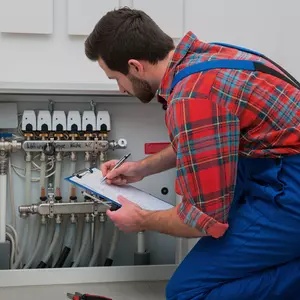
How to modernise your oil heating system
Old oil heating systems consume considerably more oil than modern boilers with condensing technology. This increases the cost of heating and is bad for the environment. Therefore, replacing or modernising your oil heating system is worth consideration.
Why you should modernise your heating now
If you modernise your oil heating system, you not only save on heating costs and protect the environment, you also make yourself less vulnerable to fluctuating oil prices. Attractive subsidies are also available.
Modernising heating systems: The following options are available
- Replace your old heating system with a modern oil heating system with condensing technology.
- Replace your old heating with a different heating system, e.g. a gas heating system with condensing technology.
- Combine different heating technologies to form a hybrid heating system.
1. Modern oil heating systems with condensing technology
An oil or gas heating system with condensing technology makes much better use of fuel than old heating systems. Both systems generate heat by burning fossil fuels. This combustion produces very hot flue gas that, in older systems, is discharged through the chimney.
In devices with condensing technology, this waste gas is cooled before being discharged and the thermal energy it contains is also utilised. This means that you require significantly less fuel to produce the same indoor temperatures.
It also decreases CO2 emissions. As this type of heating is more environmentally friendly than old systems, state subsidies are available for their installation. You can apply for a subsidy as long as your old oil heating system is not yet due for mandatory replacement.
2. Alternative heating systems, such as gas heating systems with condensing technology
Condensing technology has the same effect in gas heating systems and oil heating systems alike: it makes the heating system more efficient and sustainable. However, gas is a more environmentally friendly fuel than oil.
To be able to use a gas heating system, you must either be connected to the public gas grid or a liquid gas tank. Changing your heating to a gas heating system with condensing technology is also state-subsidised as long as you are not yet obligated to replace your old oil heating system.
3. Hybrid heating systems with heat pumps
A hybrid heating system is a combination of two or more different heating systems.
One possibility is to combine an oil heating system with a heat pump. This option is particularly suitable for older buildings. As a rule, older houses are not well insulated meaning that a heat pump alone would be insufficient to provide heating in winter.
There are various types of heat pump but they all work in the same way. The heat pump extracts heat from its surroundings, i.e. the air, ground or groundwater. It then “pumps up” this heat to a higher temperature to be used for heating purposes.
In hybrid heating systems, the heat pump handles the main heating load and usually also DHW heating. The gas or oil heating system will start up if additional heat is needed.
As heat pumps require electrical power, these hybrid heating systems can be designed to be particularly environmentally friendly if you produce this electricity on site using a photovoltaic system.
Attractive subsidies are available for installing heat pumps.
4. Hybrid heating systems with solar thermal technology
You can also combine your oil or gas heating system with solar thermal technology. In systems of this kind, solar collectors are installed on the roof of the house. But these collectors produce heat instead of electricity.
They are filled with a liquid that is heated by solar radiation. This hot liquid transmits its heat to the heating system. Solar thermal technology produces little heat in winter, so it most often forms part of a hybrid heating system.


